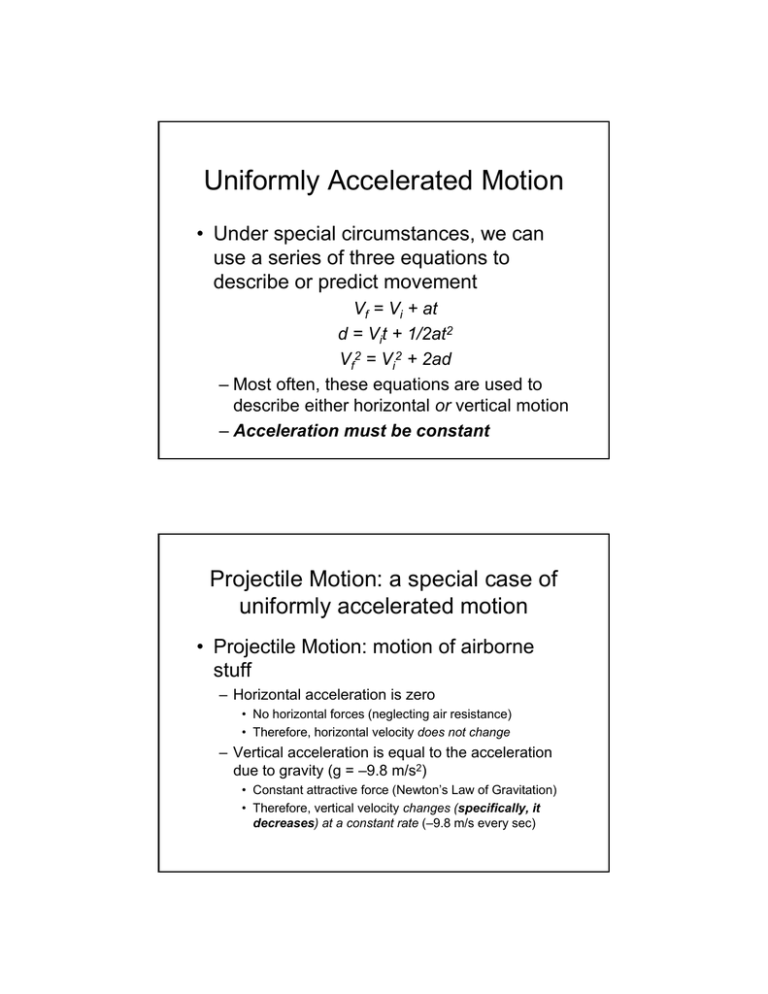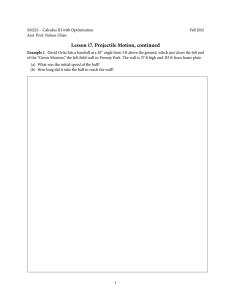Uniformly Accelerated Motion
advertisement

Uniformly Accelerated Motion • Under special circumstances, we can use a series of three equations to describe or predict movement Vf = Vi + at d = Vit + 1/2at2 Vf2 = Vi2 + 2ad – Most often, these equations are used to describe either horizontal or vertical motion – Acceleration must be constant Projectile Motion: a special case of uniformly accelerated motion • Projectile Motion: motion of airborne stuff – Horizontal acceleration is zero • No horizontal forces (neglecting air resistance) • Therefore, horizontal velocity does not change – Vertical acceleration is equal to the acceleration due to gravity (g = –9.8 m/s2) • Constant attractive force (Newton’s Law of Gravitation) • Therefore, vertical velocity changes (specifically, it decreases) at a constant rate (–9.8 m/s every sec) Projectile Motion Vertical velocity = 0 airborne motion -- parabolic path of CM constant horizontal velocity constant vertical acceleration Example • A ball is dropped from the top of a building. Its motion may be predicted using the previous equations. Time (s) 1 Position (m) d= Velocity (m/s) Vf = 2 d= Vf = –19.6 3 d = –44.1 Vf = 4 d= Vf = Acceleration (m/s2) –9.8 Important Characteristics of Projectile Motion • Center of mass (CM) of projectile will travel in a parabolic path - regardless of the motion of the individual body segments. • Vertical velocity at the peak of the projectile’s flight will be exactly zero. • Horizontal velocity is constant (ignoring air resistance) Example: Vertical Jumping • Differences between one- and two-foot vertical jumping performances – One-foot flight height: 0.45 m – Two-foot flight height: 0.54 m • What were the vertical velocities of the athlete’s CM at takeoff for each jump? – What information do we have? – What information do we want? – What equation(s) will help us get there? One-foot jumps • know: • use: • want: • solution: Factors Which Influence Projectile Motion • Velocity of release – Magnitude of the velocity (= speed): how fast? – Angle of release: at what orientation? • Relative height of release – from what height was the projectile released? – at what height did the projectile land? • Combined, these three factors (speed, angle, and height) determine how fast, how high, how long, and how far a j til ill t l ‘speed of release’ ‘angle of release’ ‘relative height’ velocity is a vector it has a horizontal and vertical component Two Types of Problems • Height of takeoff = height of landing – Example: kicking a soccer ball on a level field for maximum distance. • timeup = timedown • vertical speed at takeoff = vertical speed at landing • Height of takeoff ≠ height of landing – Example: shooting a basketball. • timeup > timedown • vertical speed at takeoff > vertical speed at basket Importance of Speed, Angle, and Height of Release • Speed of release: most important – Increases in VH increase distance. – Increases in VV increase time of flight. • Height of release – Increases time of flight. VH and VV remain same • Angle of release – Affects ratio of horizontal and vertical velocities. Overall, effect is minimal since increases in one are offset by decreases in the other. Factors affecting the ‘Range” of a projectile SPEED OF RELEASE Speed of Release • Increases in speed of release increase two release parameters in the same direction: dH = VH · tTotal tTotal = 2 ·VV/g Speed of Release ÇVR VR VH Ç VV VV Ç VH HEIGHT OF RELEASE Height of Release • In most circumstances, increases in height of release will only affect time down. • Therefore, only a portion of one parameter is increased tTotal = tup + tdown Height of Release VR VR VV VV VH VH ANGLE OF RELEASE This graph is WRONG!!! Do you know why? Original angle VR Steep angle VV VH Flat angle VR ÇVV ÈVH VR ÈVV ÇVH Optimum angle of release • If the height of takeoff is equal to the height of landing, the optimum angle of release is always 45 degrees. • If the height of takeoff is greater than the height of landing – The optimum angle is always less than 45 deg. – For any given height of release, increasing the speed of release results in an optimum angle which approaches 45 degrees. – For any given speed of release, increasing the height of release results in a decrease in the optimum angle. For any given height of release, increasing the speed of release results in an optimum angle which approaches 45 degrees. • • • Increasing the speed of release will increase VH and time of flight (by increasing VV). As speed increases, optimal angle approaches 45 degrees to balance the positive effects provided by increasing VH and and by increasing the time of flight (by increasing VV). As long as the height of release is positive (> 0), the optimum angle will be smaller than 45 degrees. It never actually reaches 45 degrees because there is some increased time of flight from the positive takeoff height. • • • Increasing the height of release will increase time of flight by increasing tDOWN (the time taken for the object to travel from the peak height to landing). Therefore, more of the velocity component should be directed horizontally. Greater vertical velocity is not necessary because increasing the time of flight can be increased by increasing the height of release. As a result, the velocity vector can be oriented more horizontally. That is, the optimum angle should get smaller (flatter). Increasing Height For any given speed of release, increasing the height of release results in a decrease in the optimum angle. decreasing optimum angle Long Jump • What is the optimum angle of takeoff for long jumpers? Long Jump • relative height > 0 – optimum angle will be less than 45 degrees – when consider the speed of takeoff the optimal angle should be about 42-43 degrees – however, in reality the angle of takeoff is about 15-25 degrees • WHY? Long Jump v 2 sinθ cosθ + v cosθ (v sinθ )2 + 2gh R= g • This is the “Range” Equation • Notice that R (range) is proportional to v2 • Therefore, velocity most important component • Jumpers can achieve 43 degrees at takeoff but have to slow down Long Jump • Moving at 10 m/s – foot not on ground long enough to generate a large takeoff angle – so maintain speed and live with a low takeoff angle • v is the most important factor in projectile motion VALUES FOR HYPOTHETICAL JUMPS UNDER DIFFERENT CONDITIONS Variable Speed of Takeoff Angle of Takeoff Values for Actual Jump (1) Speed of Takeoff Increased 5% (2) Angle of Takeoff Increased 5% (3) Relative Height of Takeoff Increased 5% (4) 8.90 m/s 9.35 m/s 8.90 m/s 8.90 m/s 20 20 21 20 Relative Ht of Takeoff 0.45 m 0.45 m 0.45 m 0.47 m Horizontal Range 6.23 m 6.77 m 6.39 m 6.27 m 0.54 m 0.16 m 0.04 m 7.54 m 7.16 m 7.04 m Change in Horiz Range Distance of Jump -- 7.00 m


